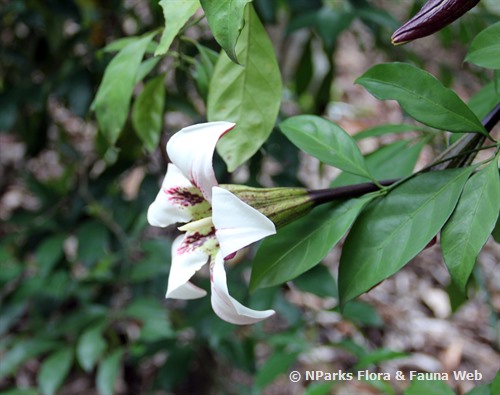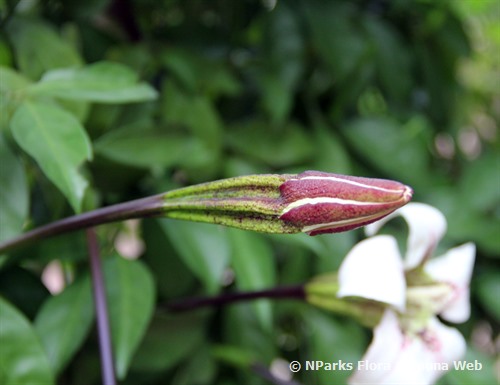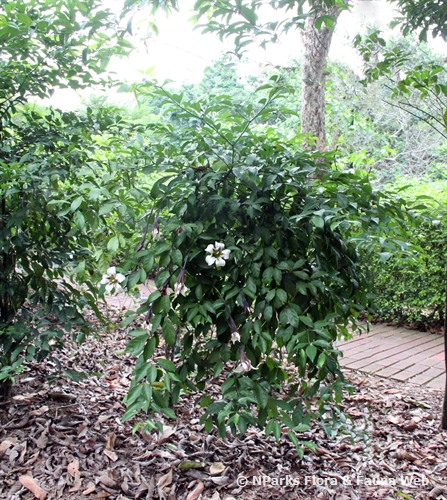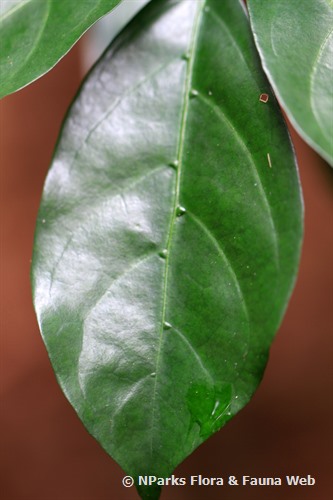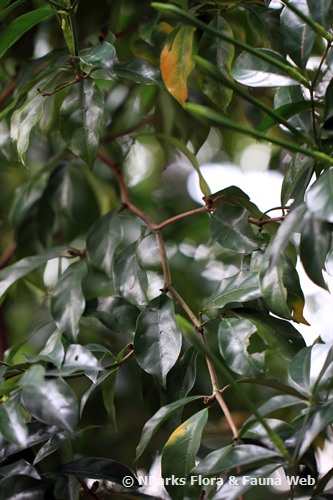
Back
Rothmannia longiflora Salisb.
| Family Name: | Rubiaceae |
| Synonyms: | Randia maculata, Randia stanleyana |
| Common Name: | Terompet Gading |
Name
Classifications and Characteristics
| Plant Division | Angiosperms (Flowering Seed Plants) (Dicotyledon) |
|---|---|
| Plant Growth Form | Tree (Shrubby (1m-5m), Small (6m-15m)), Shrub |
| Lifespan (in Singapore) | Perennial |
| Mode of Nutrition | Autotrophic |
Biogeography
| Native Distribution | Africa |
|---|---|
| Native Habitat | Terrestrial |
| Preferred Climate Zone | Tropical |
| Local Conservation Status | Non-native |
Description and Ethnobotany
| Growth Form | An evergreen shrub to a small tree which can grow up to 9 m tall. |
|---|---|
| Foliage | Leaves are oppositely arranged along the stem. Leaf blade is simple, has smooth surface, elliptical in shape with entire margin. Leaf base is cuneate while apex acuminate. |
| Stems | Climbing stem. |
| Flowers | Solitary, trumpet-shaped, white to pale pinkish petals with purplish spots inside, tubular calyx, located terminally on the axillary branches. |
| Fruit | Berry, globose shape, green and ripens to black, smooth. Seeds are lens-shaped, and brown-red in colour. |
| Habitat | Found in the undergrowth of primary forest and secondary forest, at elevations of up to 1700 metres. |
| Etymology | The specific epithet longiflora means long-flowered, which refers to the long flowers. |
| Ethnobotanical Uses | Edible Plant Parts : Edible Fruits Medicinal: It is said to have analgesic properties, and the decoction of leaves, bark, roots and the twigs is applied in lotions and baths. In West Africa, the leaf pulp is used for kidney pain and diarrhoea with blood, drinking the leaf juice is said to help during childbirth and labour. Agriculture - Forestry: In Sierra Leone, the stems are used to make shafts of chisel, which are used for harvesting oil palm fruit bunches. Others: The fruits are said to be commonly used as markings on hands, body and face to imitate tattoo. A dye is made from finely crushed seeds in Nigeria. Black dye can be made from flowers. The twigs are used as chewsticks in Ghana. |
Landscaping Features
| Landscaping | It can be grown in gardens for its attractive trumpet-shaped flowers. |
|---|---|
| Desirable Plant Features | Ornamental Flowers |
| Landscape Uses | General, Parks & Gardens |
Fauna, Pollination and Dispersal
| Pollination Method(s) | Biotic (Fauna) (Insects (Bee)) |
|---|
Plant Care and Propagation
| Light Preference | Semi-Shade |
|---|---|
| Water Preference | Moderate Water |
| Plant Growth Rate | Moderate |
| Rootzone Tolerance | Moist Soils, Well-Drained Soils, Acidic (low pH) Soils |
| Propagation Method | Seed |
Foliar
| Foliage Retention | Evergreen |
|---|---|
| Mature Foliage Colour(s) | Green |
| Mature Foliage Texture(s) | Smooth |
| Prominent Young Flush Colour(s) | Green |
| Young Flush Texture(s) | Smooth |
| Foliar Type | Simple / Unifoliate |
| Foliar Arrangement Along Stem | Opposite |
| Foliar Attachment to Stem | Petiolate |
| Foliar Shape(s) | Non-Palm Foliage (Elliptical) |
| Foliar Venation | Pinnate / Net |
| Foliar Margin | Entire |
| Foliar Apex - Tip | Acuminate |
| Foliar Base | Cuneate |
Floral (Angiosperm)
| Flower & Plant Sexuality | Bisexual Flowers |
| Flower Colour(s) | Pink, White |
|---|---|
| Flower Texture(s) | Smooth |
| Flower Grouping | Solitary |
| Flower Location | Terminal |
| Individual Flower Shape | Trumpet-shaped |
| Flowering Period | Free-Flowering |
Fruit, Seed and Spore
| Mature Fruit Colour(s) | Black |
|---|---|
| Mature Fruit Texture(s) | Smooth |
| Fruit Classification | Simple Fruit |
| Fruit Type | |
| Mature Seed Colour(s) | Brown |
Image Repository
Others
| Master ID | 32824 |
|---|---|
| Species ID | 7237 |
| Flora Disclaimer | The information in this website has been compiled from reliable sources, such as reference works on medicinal plants. It is not a substitute for medical advice or treatment and NParks does not purport to provide any medical advice. Readers should always consult his/her physician before using or consuming a plant for medicinal purposes. |

